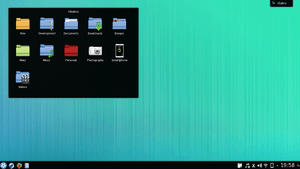Chakra (operating system)
 | |
|
Chakra with Sirius theme | |
| Developer | Chakra Team |
|---|---|
| OS family | Unix-like |
| Working state | Current |
| Source model | Open source |
| Latest release | (Half-Rolling release) / Installation medium: 2016.02-Ian[1] |
| Platforms | x86-64 |
| Kernel type | Monolithic (Linux) |
| Userland | GNU |
| Default user interface | KDE Plasma Desktop |
| License |
Free software licenses (mainly GPL) |
| Official website |
chakralinux |
Chakra (officially Chakra GNU/Linux) is a Linux distribution originally based on Arch Linux and focused on the latest KDE software, intending to provide a KDE/Qt minimizing use of other widget toolkits where possible. It has been well received by critics.[2][3]
History
In June 2006 a group of Arch Linux users initiated the KDEmod packaging project to improve and simplify a standard KDE installation with Arch Linux. In December 2008 the group released their first custom made ISO with a preconfigured Arch + KDEmod + Tribe.[4] After several releases lead developer Jan Mette suggested to split from Arch to allow for a much closer integration with KDE software.
On August 30, 2010 the first independent version, called Chakra 0.2 was released.[5] This ended the development on KDEmod and the project was renamed to "The Chakra Project".[6]
Features
Chakra includes both free and proprietary software, though the latter may be disabled during installation. It is only available for the x86_64 architecture, with support for i686 having been dropped in August 2012.[7] It is based on KDE Software Compilation.
Chakra does not schedule releases for specific dates but uses a "Half-Rolling release" system. This means that the core packages of Chakra (graphics, audio, etc.) are frozen and only updated to fix any security problems. These packages are updated after the latest versions have been thoroughly tested before being moved to permanent repository (about every six months). This allows stable base to ensure stability to the rest of the programs. The other applications (web browsers, games, media players, office suites, etc.) are updated following the rolling release model and are generally available immediately after their release.
Installation
The Chakra website supplies ISO images that can be run from CD, DVD or USB. The ISO images provide two versions, full edition and minimal edition. The graphical Chakra installation program is called "Calamares".
Package management
Repositories
Currently, the following main repositories exist:
- core, which contains all the packages needed to set up a base system.
- desktop, which contains KDE Software Compilation packages and Chakra tools.
- gtk, which contains various well-known GTK applications.
- lib32, a centralized repository for x86_64 users to more readily support 32-bit applications in a 64-bit environment.
And, testing repositories that include package candidates for other repositories. Currently, the following testing repositories exist:
- testing, with packages for stable repositories.
In addition, there also exist unstable repositories that include applications that are still considered to be unstable. There are also packages built right from the git, not waiting for an official release. Currently, the following unstable repositories exist:
- unstable, which contains development versions of general packages.
- kde-unstable, which contains development versions of KDE Software Compilation packages.
Chakra Community Repository (CCR)
In addition to the official repositories, users can install packages from the Chakra Community Repository (CCR). The CCR provides user made PKGINFOs and PKGBUILD scripts for software which is not included in the official repositories and is inspired by the Arch User Repository. CCR packages simplify building from source by explicitly listing and checking for dependencies and configuring the install to match the Chakra architecture. The CCR helper programs can further streamline the downloading and building process.
A CCR package with many votes and which conforms to the Chakra software policy may be transferred to the official repositories.[8]
References
- ↑ "Chakra 2016.02 "Ian" released". Retrieved 2016-02-29.
- ↑ "Chakra Linux review – KDE and Arch make for a winning combination". Linux User & Developer. 20 July 2011. Retrieved 2014-09-10.
- ↑ "Chakra Review: Arch Fork For Mortals". Muktware. January 2012. Retrieved 2014-09-10.
- ↑ "Chakra Wiki, History". Retrieved 2014-09-10.
- ↑ "Distribution Release: Chakra GNU/Linux 0.2.0". August 30, 2010.
- ↑ "Goodbye KDEmod !". Retrieved 2014-04-08.
- ↑ "Chakra phasing out i686 support". Retrieved 2014-04-08.
- ↑ "CCR home". Retrieved 2014-04-08.
External links
- Official website
- Chakra at DistroWatch
-
 Media related to Chakra at Wikimedia Commons
Media related to Chakra at Wikimedia Commons

